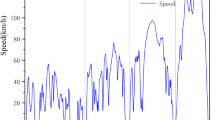Abstract
Advanced vehicular control technologies rely on accurate speed prediction to make ecological and safe decisions. This paper proposes a novel stochastic speed prediction method for connected vehicles by incorporating a Bayesian network (BN) and a Back Propagation (BP) neural network. A BN model is first designed for predicting the stochastic vehicular speed in a priori. To improve the accuracy of the BN-based speed prediction, a BP-based predicted speed error compensation module is constructed by formulating a mapping between the predicted speed and whose corresponding prediction error. In the end, a filtering algorithm is developed to smoothen the compensated stochastic vehicular speed. To validate the workings of the proposed approaches in experiments, two typical scenarios are considered: one predecessor vehicle in a double-vehicle scenario and two predecessor vehicles in a multi-vehicle scenario. Simulation results under the considered scenarios demonstrate that the proposed BN-BP fusion method outperforms the BN-based method with respect to the root mean square error, standardized residuals, R-squared, and the online prediction time of proposed fusion prediction can satisfy a real-time application requirement. The main highlighted contributions of this article are threefold: (1) We put forward an improved BN method, which is combined with a BP neural network, to construct a stochastic vehicular speed prediction method under connected driving; (2) different from existing methods, a unique interconnected framework that consists of a stochastic vehicular speed prediction module, a compensation module, and a speed smoothing module is proposed; (3) extensive simulation studies based on a set of evaluation metrics are illustrated to reveal the advantages and merits of the proposed approaches.
Similar content being viewed by others
References
Zhang F, Hu X, Langari R, et al. Energy management strategies of connected HEVs and PHEVs: Recent progress and outlook. Prog Energy Combust Sci, 2019, 73: 235–256
He C R, Orosz G. Saving fuel using wireless vehicle-to-vehicle communication. In: American Control Conference (ACC). Seattle: IEEE, 2017. 4946–4951
Asher Z D, Baker D A, Bradley T H. Prediction error applied to hybrid electric vehicle optimal fuel economy. IEEE Trans Contr Syst Technol, 2018, 26: 2121–2134
Liu K, Asher Z, Gong X, et al. Vehicle velocity prediction and energy management strategy part 1: Deterministic and stochastic vehicle velocity prediction using machine learning. SAE Technical Paper. Detroit, 2019
Shin J, Sunwoo M. Vehicle speed prediction using a markov chain with speed constraints. IEEE Trans Intell Transp Syst, 2019, 20: 3201–321
Hu Y, Chen C, He J, et al. IoT-based proactive energy supply control for connected electric vehicles. IEEE Internet Things J, 2019, 6: 7395–7405
Zhang F, Xi J, Langari R. Real-time energy management strategy based on velocity forecasts using V2V and V2I communications. IEEE Trans Intell Transp Syst, 2017, 18: 416–430
Yang J Y, Chou L D, Tung C F, et al. Average-speed forecast and adjustment via VANETs. IEEE Trans Veh Technol, 2013, 62: 4318–4327
Pei J Z, Su Y X, Zhang D H, et al. Velocity forecasts using a combined deep learning model in hybrid electric vehicles with V2V and V2I communication. Sci China Tech Sci, 2020, 63: 55–64
Ciccarese G, Donateo T, Palazzo C. On-board prediction of future speed profile for energy management of hybrid electric vehicles. Int J Automo Technol Manage, 2012, 12: 232–251
Ma D, Zhou T, Chen J, et al. Supercritical water heat transfer coefficient prediction analysis based on BP neural network. Nucl Eng Des, 2017, 320: 400–408
Wang W, Xi J, Chen H. Modeling and recognizing driver behavior based on driving data: A survey. Math Problems Eng, 2014, 2014: 1–20
Kolmanovsky I V, Filev D P. Stochastic optimal control of systems with soft constraints and opportunities for automotive applications. In: 2009 IEEE Control Applications (CCA) & Intelligent Control (ISIC). St. Petersburg, 2009
Jiang B, Fei Y. Vehicle speed prediction by two-level data driven models in vehicular networks. IEEE Trans Intell Transp Syst, 2017, 18: 1793–1801
Sun C, Moura S J, Hu X S, et al. Dynamic traffic feedback data enabled energy management in plug-in hybrid electric vehicles. IEEE Trans Contr Syst Technol, 2015, 23: 1075–1086
di Cairano S, Liang W, Kolmanovsky I V, et al. Power smoothing energy management and its application to a series hybrid powertrain. IEEE Trans Contr Syst Technol, 2013, 21: 2091–2103
Moser D, Waschl H, Schmied R, et al. Short term prediction of a vehicle’s velocity trajectory using ITS. SAE Int J Passeng Cars — Electron Electr Syst, 2015, 8: 364–370
Moser D, Schmied R, Waschl H, et al. Flexible spacing adaptive cruise control using stochastic model predictive control. IEEE Trans Contr Syst Technol, 2018, 26: 114–127
Zhang S, Luo Y, Wang J, et al. Predictive energy management strategy for fully electric vehicles based on preceding vehicle movement. IEEE Trans Intell Transp Syst, 2017, 18: 3049–3060
Shao C, Wei L. Traffic Flow Theory (in Chinese). Beijing: Electronic Industry Press, 2012
Planung Transport Verkehr AG. VISSIM 4.3 User Manual. Karlsruhe: Planung Transport Verkehr AG, 2007
Wang D, Jin S. Review and outlook of car following behavior. J China Highway, 2012, 25: 115–127
Murphy K P. Machine Learning: A Probabilistic Perspective (Adaptive Computation and Machine Learning Series). Cambridge: MIT Press, 2012
Murphy K P. Fitting a conditional linear gaussian distribution. 1998. https://www.cs.ubc.ca/murphyk/Papers/learncg.pdf
Author information
Authors and Affiliations
Corresponding authors
Additional information
This work was supported by the National Natural Science Foundation of China (Grant Nos. 51905419 and 51175419).
Rights and permissions
About this article
Cite this article
Wang, L., Cui, Y., Zhang, F. et al. Stochastic speed prediction for connected vehicles using improved bayesian networks with back propagation. Sci. China Technol. Sci. 65, 1524–1536 (2022). https://doi.org/10.1007/s11431-021-2037-8
Received:
Accepted:
Published:
Issue Date:
DOI: https://doi.org/10.1007/s11431-021-2037-8




